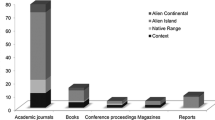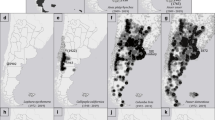Abstract
Nowhere are the negative impacts of invasive species, such as ecosystem modification, predation, parasitism, and disease, more apparent than in the Pacific islands, where human contact triggered a massive avian extinction event that is still ongoing. Island bird species are inherently vulnerable to extinction due to their small, isolated populations and lack of evolved defenses against many predators. To prevent further extinctions, effective bird conservation strategies must be implemented to mitigate invasive species’ impacts, which often interact synergistically and collectively comprise some of the greatest threats to global biodiversity. At the 2014 International Ornithological Congress in Tokyo, Japan, researchers convened a symposium to address research and management of invasive species to benefit Pacific island bird conservation. Speakers presented research and conservation efforts from Japan, Korea, Guam, the Galápagos, and New Zealand, highlighting novel, poorly known threats to birds (e.g., mortality from invasive plant entanglement and invasive nest parasites) and providing updates on ongoing efforts to prevent island endemic species extinctions driven by invasive predators. In this paper we provide new details of research and conservation efforts on Swinhoe’s storm petrel (Oceanodroma monhris), the Okinawa rail (Gallirallus okinawae), and the Guam rail (G. owstoni), and put this research in context by briefly reviewing and synthesizing other relevant, recent studies on impacts of invasive species as they affect Pacific island bird conservation. We conclude by highlighting successful management strategies, recommending improvements for ongoing conservation efforts, and suggesting directions for future research.






Similar content being viewed by others
References
Banko PC, Hess SC, Snowcroft PG et al (2014) Evaluating the long-term management of introduced ungulates to protect the palila, an endangered bird and its critical habitat in subalpine forest of Mauna Kea, Hawai’i. Arct Antarct Alp Res 46:871–889
Barun S, Hanson CC, Campbell KJ, Simberloff D (2011) A review of the small Indian mongoose management and eradications on islands. In: Veitch CR, Clout MN, Towns DR (eds) Island invasives: eradication and management. IUCN, Gland, pp 17–25
BirdLife International (2015) IUCN Red List for birds. Downloaded from http://www.birdlife.org on 11/04/2015
Blackburn TM, Cassey P, Duncan RP, Evans KL, Gaston KJ (2004) Avian extinction and mammalian introductions on oceanic islands. Sci 305:1955–1958
Burbidge AA (2011) 2001 to 2010 and beyond: Trends and future directions in the eradication of invasive species on islands. In: Veitch CR, Clout MN, Towns DR (eds) Island invasives: eradication and management. IUCN, Gland, pp 515–519
Burger AE (2005) Dispersal and Germination of Seeds of Pisonia grandis, an Indo-Pacific tropical tree associated with insular seabird colonies. J Trop Ecol 21:263–271
Caves EM, Jennings SB, HilleRisLambers J, Tewksbury JJ, Rogers HS (2013) Natural experiment demonstrates that bird loss leads to cessation of dispersal of native seeds from intact to degraded forests. PLoS ONE 8(5):e65618. doi:10.1371/journal.pone.0065618
Choi C-Y, Nam H-Y, Chae H-Y (2010) Exotic seeds on the feathers of migratory birds on a stopover island in Korea. J Ecol Field Biol 33:19–22
Cimadom A, Ulloa A, Meidl P, Zöttl M, Zöttl E, Fessl B, Nemeth E, Dvorak M, Cunninghame F, Tebbich S (2014) Invasive parasites, habitat change and heavy rainfall reduce breeding success in Darwin’s Finches. PLoS ONE 9(9):e107518. doi:10.1371/journal.pone.0107518
Courchamp F, Caut S, Bonnaud E, Bourgeois K, Angulo E, Watari Y (2011) Eradication of alien invasive species: surprise effects and conservation successes. In: Veitch CR, Clout MN, Towns DR (eds) Island invasives: eradication and management. IUCN, Gland, pp 285–289
Croxall JP, Butchart SHM, Lascelles B, Stattersfield AJ, Sullivan B, Symes A, Taylor P (2012) Seabird conservation status, threats and priority actions: a global assessment. Bird Conserv Int 22:1–34
East Asian-Australasian Flyway Partnership. 2010. Information Sheet on Flyway Network Sites: Chilbaldo Islet. http://www.eaaflyway.net/documents/network/sis/sis-rok-eaaf107.pdf
Ferraro PJ, McIntosh C, Ospina M (2007) The effectiveness of the US endangered species act: an econometric analysis using matching methods. J Envir Econ Man 54:245–261
Fessl B, Tebbich S (2002) Philornis downsi—a recently discovered parasite on the Galápagos archipelago—a threat for Darwin’s finches? Ibis 144:445–451
Fraser D, Galbraith M, Adams N, Blanchon D (2014) Range extension of the spur-winged plover (Vanellus miles novaehollandiae) in New Zealand. Notornis 61:49–53
Gaston AJ (2004) Seabirds: a natural history. Yale University Press, New Haven
Hager SB, Dziadyk B, McKay KJ (2009) Bird-plant entanglement: a review and addition of the Least Flycatcher. Wilson J Ornith 121:648–651
Handler AT, Gruner DS, Haines WP, Lange MW, Kaneshiro K (2007) Arthropod surveys on Palmyra Atoll, Line Islands, and insights into the decline of the native tree Pisonia grandis (Nyctaginaceae). Pac Sci 61:485–502
Hess SC, Banko PC, Goltz DM, Danner RM, Brinck KW (2004) Strategies for reducing feral cat threats to endangered Hawaiian birds. Proc Vert Pest Conf 21:21–26
Hess SC, Hansen H, Banko PC (2007) Ecology of an invasive predator in Hawai‘i. In: Witmer GL, Pitt WC, Fagerstone KA (eds) Managing Vertebrate Invasive Species: Proceedings of an International Symposium. Fort Collins, USDA/APHIS
Humphries GW, Huettmann F (2012) Global Issues for, and Profiles of, Arctic Seabird Protection: Effects of Big Oil, New Shipping Lanes, Shifting Baselines, and Climate Change. In: Huettmann F (ed) Protection of the Three Poles. Springer, Tokyo, pp 217–245
Ishida K, Murata K., Nishiumi I, Takahashi Y, Takashi M (In press) Endemic Amami Jay, invasive small Indian mongoose, and other alien organisms: a new century investigation of island aliens toward improved ecosystem management. J Ornith
Jeonnam Province (2000) Natural environmental survey report: Gugul, Chilbal, and Chilsan Islands. Jeonnam Province, Gwangju
Kessler CC (2002) Eradication of feral goats and pigs and consequences for other biota on Sarigan Island, Commonwealth of the Northern Mariana Islands. In: Veitch CR, Clout MN (eds) Turning the tide: the eradication of invasive species. IUCN SSC Invasive Species Specialist Group, IUCN, pp 132–140
Lee K-S, Won P-O (1988) Breeding biology of Swinhoe’s fork-tailed petrel Oceanodroma monorhis (Swinhoe) on Chilbal Islet, Korea. Bull Korea Inst Ornithol 2:39–60
Lee K-G, Ko G-N, Jegal GM, Park CA (2009) Impacts of introduced plants on the breeding of Swinhoe’s Storm Petrels (Oceanodroma monorhis) and conservation activities in Shinan-gun County, Korea. In: Chae H-Y, Choi C-Y, Nam H-Y (eds) Seabirds in Danger: Invasive Species and Conservation of Island Ecosystem. National Park Migratory Birds Center, Shinan, Korea
Lee D-P, Lee K-G, Nam D-H (2012) Population declines and heavy metal exposure of Swinhoe’s Storm Petrels (Oceanodroma monorhis) breeding on the southwest coast of Korea. Marine Pollution Bull 64:2645–2649
Lindsey GD, Hess SC, Campbell EW III, Sugihara RT (2009) Small mammals as predators and competitors. In: Pratt T, Banko P, Atkinson C, Jacobi J, Woodworth B (eds) Conservation biology of Hawaiian forest birds: implications for island Avifauna. Yale University Press, New Haven, pp 274–292
Loehle C, Eschenbach W (2012) Historical bird and terrestrial mammal extinction rates and causes. Divers Distrib 18:84–91
MacDougall AS, Turkington R (2005) Are invasive species the drivers of passengers of change in degraded ecosystems? Ecology 86:42–55
Meyer J-Y (2014) Critical issues and new challenges for research and management of invasive plants in the Pacific islands. Pac Cons Biol 20:146–164
Nam K-B, Lee K-G, Hwang J-W, Yoo J-C (2014) Variation in breeding burrows of Streaked Shearwaters breeding in Sasu Island, and predation rates by Norway Rats. Ocean and Polar Res 36:49–57
National Research Institute of Cultural Properties (2008) Assessment of Natural Monument Islands and their Conservation and Management. National Research Institute of Cultural Properties, Daejeon, Korea. Publication No. 11-1550011-000266-01
Neumann G, O’Dowd DJ, Gullan PJ, Green PT (2014) First record of Pulvinaria urbicola Cockerell (Hemiptera: coccidae), a potentially damaging scale insect, on Christmas Island. Indian Ocean. J. Asia-Pac Ent 17:27–30
Oppel S, Beaven BM, Bolton M et al (2011) Plans to eradicate invasive mammals on an island inhabited by humans and domestic animals (Corvo, Azores, Portugal). Julius-Kühn-Archiv 432:42–43. doi:10.5073/jka.2011.432.018
Ozaki K, Komeda S, Baba T, Toguchi Y, Harato T (2006) Declining distribution of the Okinawa Rail: impact of introduced predators. J Ornith 147:103–104
Park J-Y, Won P-O (1993) Survey of seabirds breeding in Korea. Bull Korea Inst Ornithol 4:101–105
Peck R, Banko P, Pendleton F (2014) Developing tools to eradicate ecologically destructive ants on Rose Atoll: effectiveness and attractiveness of formicidal baits. Tech Rep HCSU-052, University of Hawaii
Pitt W, Vice D, Lujen D, Vice D, Witmer G (2012) Freeing islands of rodents: Broadcast rodenticides help native species recover. USDA National Wildlife Research Center Paper 1182
Rodda GH, Fritts TH (1992) The impact of the introduction of the colubrid snake Boiga irregularis on Guam lizards. J Herpetol 26:166–174
Rodda GH, Savidge JA (2007) Biology and Impacts of Pacific Island Invasive Species. 2. Boiga irregularis, the Brown Tree Snake (Reptilia: colubridae). Pac Sci 61:307–324
Sato F, Karino K, Oshiro A, Sugawa H, Hirai M (2010) Breeding of Swinhoe’s Storm Petrel Oceanodroma monorhis in the Kutsujima islands. Kyoto. Jpn. Mar Ornith 38:133–136
Savidge JA (1987) Extinction of an island forest avifauna by an introduced snake. Ecology 68:660–668
Shinan County Office (2012) Seabird Restoration Plan on Chilbal and Gugul Islands. Shinan County Office, Shinan
Steadman DW (2006) Extinction and biogeography of tropical island birds. U Chicago Press, Chicago
Szabo JK, Khwaja N, Garnett ST, Butchart SHM (2012) Global patterns and drivers of avian extinctions at the species and subspecies level. PLoS ONE 7:e47080
Tanaka H, Amano H, Uesato T (2006) A new record of Pulvinaria urbicola Cockerell, 1893 (Hemiptera, Coccidae) from Japan. Jpn J Sys Entomol 12:177–181
Traylor-Holzer K (2006) Okinawa Rail PVA Workshop Report, IUCN Conservation Breeding Specialist Group. Available at: http://www.cbsg.org/sites/cbsg.org/files/documents/Okinawa%20rail%20PHVA%20(2006).pdf
Veitch CR, Clout MN, Towns DR (eds) (2011) Island invasives: eradication and management. IUCN, Gland
Walker TA (1991) Pisonia Island of the Great Barrier Reef. Atoll Research Bulletin No. 350. National Museum of Natural History Smithsonian Institute, Washington DC
Zarones L, Sussman A, Morton JM, Plentovich S, Faegre S, Aguon C, Amar A, Ha RR (2014) Population status and nest success of the critically endangered Mariana Crow (Corvus kubaryi) on Rota, Northern Mariana islands. Bird Conserv Int 25:220–233. doi:10.1017/S0959270914000045
Acknowledgments
We are grateful to the organizers of the International Ornithological Congress (IOC) for the opportunity to present some of this research at the meeting in Tokyo in 2014. N. Arcilla received kind support from the IOC and the American Ornithologists’ Union to participate. C.-Y. Choi received research support from Shinan County and the Korea National Park Service. K. Ozaki received research support from NPO Doubutsutachino-byoin, Okinawa, Nature Conservation Division, Okinawa Prefectural Government, Yanbaru Wildlife Conservation Center, Ministry of the Environment, and The Environment Research and Technology Development Fund. S. Medina contributed data for the Guam Rail and her research is supported by the Guam Department of Agriculture and US Federal Aid (Wildlife Restoration Funds and Endangered Species Sect. 6 grants). We thank K. Ishida and E. Matthysen as well as two anonymous reviewers and the editor for advice and assistance in preparing this paper. All research was carried out in compliance with the laws of the country in which it was performed.
Author information
Authors and Affiliations
Corresponding author
Additional information
Communicated by E. Matthysen.
Rights and permissions
About this article
Cite this article
Arcilla, N., Choi, CY., Ozaki, K. et al. Invasive species and Pacific island bird conservation: a selective review of recent research featuring case studies of Swinhoe’s storm petrel and the Okinawa and Guam rail. J Ornithol 156 (Suppl 1), 199–207 (2015). https://doi.org/10.1007/s10336-015-1256-8
Received:
Revised:
Accepted:
Published:
Issue Date:
DOI: https://doi.org/10.1007/s10336-015-1256-8




